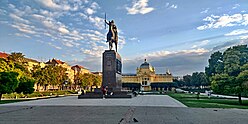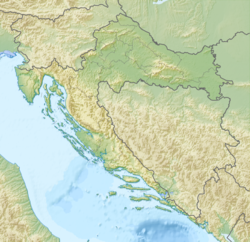Zagreb | |
|---|---|
Capital city and county | |
| Grad Zagreb City of Zagreb | |
Stone Gate in the Upper Town Cibona and HOTO towers Art Pavilion and Monument of the King Tomislav of Croatia | |
|
| |
 | |
 The city of Zagreb in Croatia | |
| Coordinates: 45°48′47″N 15°58′39″E / 45.81306°N 15.97750°E | |
| Country | |
| County | City of Zagreb |
| RC diocese | 1094 |
| Free royal city | 1242 |
| Unified | 1850 |
| Subdivisions | 17 city districts 218 local committees 70 settlements |
| Government | |
| • Type | Mayor-Council |
| • Mayor | Tomislav Tomašević (Možemo!) |
| • City Assembly | 48 members |
| Area | |
• City | 641.2 km2 (247.6 sq mi) |
| • Urban | 162.2 km2 (62.6 sq mi) |
| Elevation | 158 m (518 ft) |
| Highest elevation | 1,035 m (3,396 ft) |
| Lowest elevation | 122 m (400 ft) |
| Population (2021)[3] | |
• City | 767,131 |
| • Density | 1,200/km2 (3,100/sq mi) |
| • Metro | 1,086,528 |
| Demonym(s) | Zagreber (en) Zagrepčanin (hr, male) Zagrepčanka (hr, female) Purger (informal, jargon) |
| GDP (Nominal, 2022) | |
| • City | €23.12 billion |
| • Per capita | €30,138 |
| Time zone | UTC+1 (CET) |
| • Summer (DST) | UTC+2 (CEST) |
| Postal code | HR-10 000, HR-10 010, HR-10 020, HR-10040 |
| Area code | +385 1 |
| HDI (2022) | 0.938[6] very high · 1st |
| Website | zagreb |
Zagreb (/ˈzɑːɡrɛb/ ZAH-greb[7] Croatian: [zǎːɡreb] [a])[9] is the capital and largest city of Croatia.[10] It is in the north of the country, along the Sava river, at the southern slopes of the Medvednica mountain. Zagreb stands near the international border between Croatia and Slovenia at an elevation of approximately 158 m (518 ft) above sea level.[11] At the 2021 census, the city itself had a population of 767,131,[3] while the population of Zagreb metropolitan area is 1,217,150.
Zagreb is a city with a rich history dating from Roman times. The oldest settlement in the vicinity of the city was the Roman Andautonia, in today's Šćitarjevo.[12] The historical record of the name "Zagreb" dates from 1134, in reference to the foundation of the settlement at Kaptol in 1094. Zagreb became a free royal city in 1242.[13] In 1851, Janko Kamauf became Zagreb's first mayor.[14] Zagreb has special status as a Croatian administrative division—it comprises a consolidated city-county (but separate from Zagreb County),[15] and is administratively subdivided into 17 city districts.[16] Most of the city districts lie at a low elevation along the valley of the river Sava, but northern and northeastern city districts, such as Podsljeme[17] and Sesvete[18] districts are situated in the foothills of the Medvednica mountain,[19] making the city's geographical image quite diverse. The city extends over 30 km (19 mi) east-west and around 20 km (12 mi) north-south.[20][21] Zagreb ranks as a global city, with a 'Beta-' rating from the Globalization and World Cities Research Network.[22]
The transport connections, the concentration of industry, scientific, and research institutions and industrial tradition underlie its leading economic position in Croatia.[23][24][25] Zagreb is the seat of the central government, administrative bodies, and almost all government ministries.[26][27][28] Almost all of the largest Croatian companies, media, and scientific institutions have their headquarters in the city. Zagreb is the most important transport hub in Croatia: here Central Europe, the Mediterranean and Southeast Europe meet, making the Zagreb area the centre of the road, rail and air networks of Croatia. It is a city known for its diverse economy, high quality of living, museums, sporting, and entertainment events. Major branches of Zagreb's economy include high-tech industries and the service sector.
- ^ Register of spatial units of the State Geodetic Administration of the Republic of Croatia. Wikidata Q119585703.
- ^ "Statistički ljetopis Grada Zagreba 2007" (PDF). Statistički Ljetopis Zagreba (in Croatian and English). 2013. ISSN 1330-3678. Archived from the original (PDF) on 3 December 2008. Retrieved 12 November 2008.
- ^ a b "Population by Age and Sex, by Settlements" (xlsx). Census of Population, Households and Dwellings in 2021. Zagreb: Croatian Bureau of Statistics. 2022.
- ^ a b "Zagreb Urban Agglomeration Development Strategy for the period up to 2020" (PDF). www.zagreb.hr. April 2018. Archived (PDF) from the original on 29 October 2020. Retrieved 28 December 2019.
- ^ "EU regions by GDP, Eurostat". Retrieved 18 September 2023.
- ^ "Sub-national HDI - Subnational HDI - Global Data Lab". globaldatalab.org.
- ^ Wells, John C. (2008). Longman Pronunciation Dictionary (3rd ed.). Longman. ISBN 978-1-4058-8118-0.; Roach, Peter (2011). Cambridge English Pronouncing Dictionary (18th ed.). Cambridge: Cambridge University Press. ISBN 978-0-521-15253-2.
- ^ International Review of Slavic Linguistics. Linguistic Research. 1982. ISBN 9780887830464.
- ^ "Hrvatski jezični portal". Archived from the original on 27 August 2015. Retrieved 23 March 2015.
- ^ "Grad Zagreb službene stranice". Archived from the original on 20 June 2017. Retrieved 20 June 2017.
- ^ "OSNOVNI PODACI O GRADU ZAGREBU". Archived from the original on 7 June 2017. Retrieved 20 June 2017.; "Zagreb, Zagreb... – ZPR – FER". Archived from the original on 30 July 2007. Retrieved 20 June 2017.
- ^ "Arheološki park ANDAUTONIJA". Archived from the original on 1 January 2012. Retrieved 20 June 2017.; "Arheološki park ANDAUTONIJA u Ščitarjevu – Arheološki muzej u Zagrebu". Archived from the original on 29 July 2017. Retrieved 20 June 2017.; "Povijest – Andautonija". Archived from the original on 26 July 2012. Retrieved 20 June 2017.; "Andautonija – Turistička zajednica Zagrebačke županije". Archived from the original on 29 July 2017. Retrieved 20 June 2017.
- ^ "Muzej grada Zagreba – 5. Slobodni kraljevski grad na Gradecu". Archived from the original on 5 July 2017. Retrieved 20 June 2017.; "Kralj Bela IV Gradecu izdao Zlatnu bulu kojom je postao slobodni kraljevski grad". 16 November 2014. Archived from the original on 29 July 2017. Retrieved 20 June 2017.; "slobodni kraljevski gradovi i trgovišta | Hrvatska enciklopedija". Archived from the original on 30 July 2017. Retrieved 20 June 2017.; "slobodni kraljevski gradec – Grad Zagreb službene stranice". Archived from the original on 29 July 2017. Retrieved 20 June 2017.; "Zlatna bula Bele IV. – Hrvatska enciklopedija". Archived from the original on 28 July 2017. Retrieved 20 June 2017.
- ^ "Zagrebački gradonačelnici – Grad Zagreb službene stranice". Archived from the original on 12 June 2017. Retrieved 20 June 2017.; "Popis gradonačelnika grada Zagreba / ZGportal Zagreb". Archived from the original on 10 July 2017. Retrieved 20 June 2017.; "Izabran prvi zagrebački gradonačelnik u povijesti – 1851". 14 May 2014. Archived from the original on 29 July 2017. Retrieved 20 June 2017.; "15. svibnja 1851. – tko je bio prvi gradonačelnik Zagreba?". narod.hr. 15 May 2017. Archived from the original on 29 July 2017. Retrieved 20 June 2017.
- ^ "Kakav je status Grada Zagreba? – Ministarstvo uprave". Archived from the original on 29 July 2017. Retrieved 20 June 2017.; "Popis županija, gradova i općina". Archived from the original on 29 July 2017. Retrieved 20 June 2017.; "Sustav lokalne i područne (regionalne) samouprave". Archived from the original on 29 July 2017. Retrieved 20 June 2017.; "Zakon o Gradu Zagrebu – Zakon.hr". Archived from the original on 29 July 2017. Retrieved 20 June 2017.
- ^ "Gradske četvrti – Grad Zagreb službene stranice". Archived from the original on 18 June 2017. Retrieved 20 June 2017.; "Gradske četvrti grada Zagreba / ZGportal Zagreb". Archived from the original on 19 June 2017. Retrieved 21 June 2017.; "Doznajte kako su glasale pojedine gradske četvrti Zagreba – Dnevnik.hr". Archived from the original on 27 June 2017. Retrieved 20 June 2017.
- ^ "Gradska četvrt Podsljeme – Grad Zagreb službene stranice". Archived from the original on 29 May 2017. Retrieved 20 June 2017.; "Karta Podsljeme – Zagreb – Karta Zagreba". Archived from the original on 5 July 2017. Retrieved 20 June 2017.; "Gradska četvrt Podsljeme / ZGportal Zagreb". Archived from the original on 29 July 2017. Retrieved 20 June 2017.
- ^ "Udaljenost Sesvete - Zagreb - Udaljenosti.com". Archived from the original on 27 June 2017. Retrieved 20 June 2017.; "Karta Sesvete – Zagreb – Karta Zagreba". Archived from the original on 5 July 2017. Retrieved 20 June 2017.; "Sesvete – Karta Zagreba". Archived from the original on 28 June 2017. Retrieved 20 June 2017.
- ^ "Medvednica / Simboli grada Zagreba / ZGportal Zagreb". Archived from the original on 29 July 2017. Retrieved 20 June 2017.
- ^ "Zagreb – Google Karte". Archived from the original on 22 November 2018. Retrieved 20 June 2017.
- ^ "Karta Zagreba". Archived from the original on 8 April 2022. Retrieved 20 June 2017.
- ^ "The World According to GaWC 2020". GaWC - Research Network. Globalization and World Cities. Archived from the original on 12 June 2022. Retrieved 31 August 2020.
- ^ "Zagreb – naša metropola". Archived from the original on 16 July 2017. Retrieved 20 June 2017.
- ^ "Zagreb – moderna metropola bogate povijesti – HUP Zagreb". Retrieved 20 June 2017.[permanent dead link]
- ^ "Grad Zagreb – Velegrad zelenog srca – Jutarnji List". 21 August 2010. Archived from the original on 29 July 2017. Retrieved 21 June 2017.
- ^ "Republika Grad Zagreb – STav". Archived from the original on 8 April 2022. Retrieved 20 June 2017.
- ^ "Unitarna i centralizirana Hrvatska zrela za redizajn – Glas Slavonije". Archived from the original on 29 July 2017. Retrieved 20 June 2017.
- ^ "Sindikati traže izdvajanje Grada Zagreba iz statističke podjele RH". Archived from the original on 29 July 2017. Retrieved 20 June 2017.
Cite error: There are <ref group=lower-alpha> tags or {{efn}} templates on this page, but the references will not show without a {{reflist|group=lower-alpha}} template or {{notelist}} template (see the help page).











